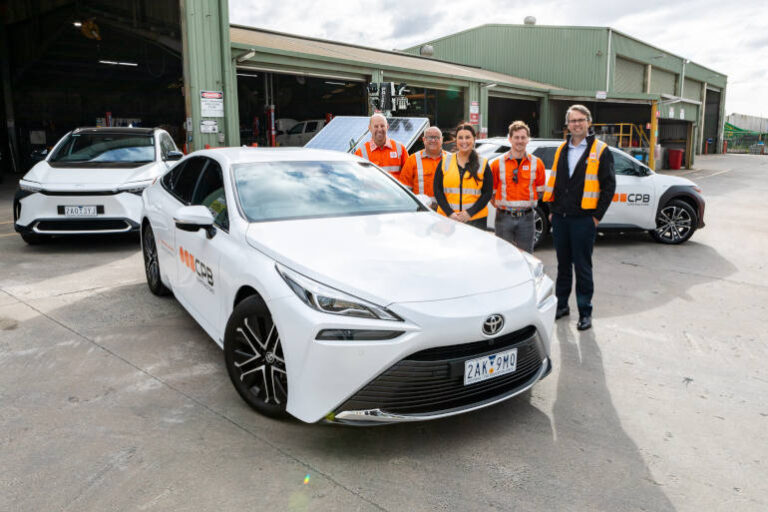Australia’s largest construction company and a member of the CIMIC Group, CPB Contractors has introduced Toyota’s new Mirai fuel cell electric vehicle (FCEV) into its fleet of vehicles. The integration of hydrogen-fuelled vehicles follows the contractor’s Australian-first pilot of Toyota’s prototype HiAce powered by a hydrogen-fuelled internal combustion engine (ICE) earlier this year.
Two Toyota Mirai vehicles have replaced traditional diesel or petrol-fuelled assets in Melbourne and Brisbane, both to be utilised to transport workers between CPB Contractors’ major metropolitan infrastructure projects in each city.
The Toyota Mirai is Toyota’s first mass-produced fuel cell vehicle, pioneering a new era of sustainable mobility for the manufacturer. CPB Contractors’ utilisation of the vehicles as pool vehicles ensures maximum exposure and access for workers, clients, subcontractors and partners, providing them the opportunity to experience the latest in new energy-fuelled technology.
CPB Contractors General Manager Renewables, Systems and Technology, Jason Pearson said, “As a leading contractor, the size and scale of our projects presents incredible opportunity to trial new innovations to reduce emissions, create efficiencies and support the ESG targets of our projects, our clients and our business. We have a longstanding partnership with Toyota and are privileged to be provided early access to trial their prototypes and purchase the latest fleet of vehicles. Hydrogen presents a very real solution in the new energy space and the new Toyota Mirai is a vital step in solving the energy demands and emission challenges that come with traditional petrol and diesel-fuelled vehicles.”
With a vision to making fuel cell vehicles widely available to consumers, Toyota launched the second-generation Mirai for lease by fleet customers in 2021, providing motorists a zero tailpipe emission driving experience. The Mirai does not directly link to electricity from the grid, rather it generates its own electricity from hydrogen and air, converted to electricity through its onboard fuel cell.
Toyota Australia Vice President of Sales and Marketing, Sean Hanley, said Toyota is proud to be working with long-standing partner, CPB Contractors to support their commitment to lowering emissions within their vehicle fleet.
“The Toyota Mirai FCEV is an important part of our multi-pathway approach to reducing carbon tailpipe emissions,” he said. “Since 2018, Toyota has been expanding our hydrogen capability here in Australia, first with local trials of the first-generation Mirai FCEV, and then in 2021 the establishment of Victoria’s first hydrogen production, storage and refuelling facility and launch of the second-generation Mirai FCEV for lease by fleet customers.
“Our goal is to make hydrogen vehicles and technology more widely available to Australians to help grow the hydrogen economy and support decarbonisation, and partnering with CPB Contractors is another step towards realising this.”
CPB Contractors is accessing hydrogen from Toyota’s Product Centre in Altona, Melbourne, and from Port of Brisbane’s specialised hydrogen fuelling station. As access to hydrogen fuelling facilities becomes available, plans are in place to roll out the Toyota Mirai in NSW, SA, and WA.
In addition to the integration of these two new-to-market hydrogen-fuelled vehicles, CPB Contractors has furthered its commitment to seeking optimal sustainable outcomes across its fleet and projects, deploying two fully-electric Toyota bZ4X vehicles to its TasWater project in Tasmania to replace two HiLux vehicles, with the company also purchasing a further 37 Toyota HiLux 48V V-Active technology vehicles to roll out to projects across the country.
“CPB Contractors is committed to playing a key role in delivering the critical infrastructure required to transition Australia to a new energy future, and a big part of that is supporting the demand for clean energy sources, including hydrogen. We look forward to continuing our collaboration with companies like Toyota, who are at the forefront of revolutionising transport and plant technology, so we can integrate low or zero-emission vehicles and plants across all of our projects and worksites and support further research, development and capacity for production,” said Mr Pearson.






